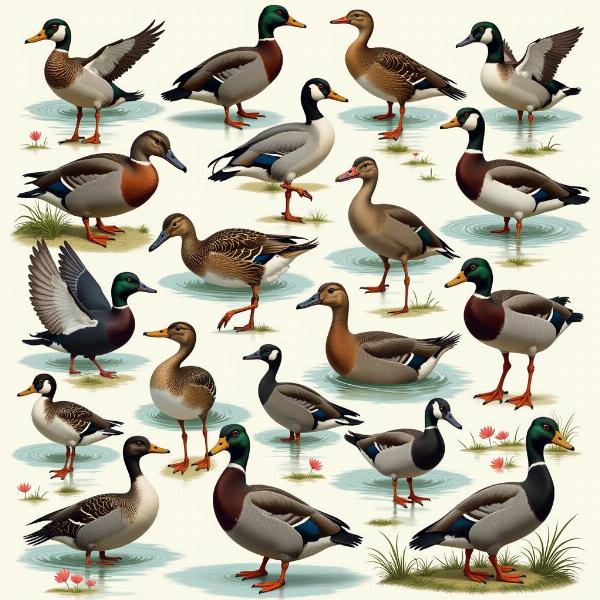Waterfowl, a common sight in India’s diverse wetlands, are birds adapted to aquatic environments. Understanding the term “waterfowl meaning in Hindi” requires exploring its various aspects, from linguistic translations to cultural significance. This guide will delve into the different Hindi words used for waterfowl, examining their nuances and contextual usage. We’ll also discuss the ecological importance of these birds and their place in Indian traditions.
Exploring the Hindi Translations of Waterfowl
While there isn’t one single, universal Hindi word for “waterfowl,” several terms capture the essence of these aquatic birds. These terms often depend on the specific type of bird being referred to. Common translations include:
- जलपक्षी (jalpakshi): This is perhaps the closest direct translation, combining “jal” (water) and “pakshi” (bird). It encompasses a broad range of aquatic birds.
- पानी के पक्षी (pani ke pakshi): This more colloquial phrase, meaning “water’s birds,” is commonly used in everyday conversation.
- बत्तख (battakh): While specifically referring to ducks, this word is often used generically for waterfowl, especially in casual contexts.
- हंस (hans): Meaning swan, this term, along with others like “सारस (saras)” for crane, is used for specific types of waterfowl.
 Waterfowl (Jalpakshi) in India
Waterfowl (Jalpakshi) in India
Waterfowl in Indian Culture and Tradition
Waterfowl hold a significant place in Indian culture, often appearing in mythology, folklore, and religious symbolism. The graceful swan (hans) is revered as a symbol of purity, knowledge, and spiritual enlightenment. Other waterfowl, like ducks and geese, are also featured in traditional stories, representing various virtues and characteristics.
The Ecological Importance of Waterfowl
Waterfowl play a crucial role in maintaining the health of aquatic ecosystems. They contribute to nutrient cycling, seed dispersal, and pest control. Their presence also serves as an indicator of wetland health, highlighting the need for conservation efforts.
What are the common types of waterfowl found in India?
India’s diverse wetlands are home to a wide array of waterfowl species. Some of the most common include various species of ducks, geese, swans, herons, egrets, ibises, and storks. These birds contribute significantly to the ecological balance of these vital habitats.
How does “waterfowl meaning in hindi” differ based on context?
The appropriate Hindi term for “waterfowl” depends on the context. In formal settings or scientific discussions, “jalpakshi” is preferred. In casual conversations, “pani ke pakshi” or specific bird names like “battakh” are more common.
Why is it important to understand the different Hindi words for waterfowl?
Understanding the nuances of different Hindi terms for waterfowl helps in accurate communication and demonstrates respect for the richness of the language. It allows for more precise descriptions and a deeper understanding of the cultural and ecological context.
Conclusion: Appreciating Waterfowl in India
Understanding “waterfowl meaning in Hindi” encompasses more than just translation. It involves appreciating the linguistic, cultural, and ecological significance of these fascinating birds. From the majestic swan to the humble duck, waterfowl enrich India’s natural heritage and hold a special place in its traditions.
FAQ
- What is the most common Hindi word for waterfowl? While “jalpakshi” is the closest direct translation, “pani ke pakshi” is often used in everyday conversation.
- Are all aquatic birds considered waterfowl? Generally, waterfowl refers to birds adapted to swimming and diving in aquatic environments.
- Why are waterfowl important for the ecosystem? Waterfowl play crucial roles in nutrient cycling, seed dispersal, and maintaining wetland health.
- What are some threats to waterfowl populations in India? Habitat loss, pollution, and hunting are some of the major threats.
- How can I contribute to waterfowl conservation? Supporting conservation organizations, participating in citizen science projects, and spreading awareness about wetland protection are some ways to contribute.
- What is the cultural significance of waterfowl in India? Waterfowl are often featured in Indian mythology and folklore, symbolizing purity, knowledge, and other virtues.
- Where can I learn more about waterfowl in India? Numerous online resources, books, and organizations dedicated to bird conservation provide further information.
Related Articles:
- birds name in hindi and english with pictures
- duck in hindi meaning
- all birds name in hindi and english
- 100 animals name in hindi and english
Meaning-Hindi.in is your trusted partner for high-quality Hindi translation services. We specialize in business, legal, technical, website, educational, and specialized translations, ensuring accurate and culturally sensitive communication. Our expertise in both Hindi language and Indian culture enables us to deliver exceptional results across diverse subject matter. Need help bridging the language gap? Contact us today at [email protected] or +91 11-4502-7584. Meaning-Hindi.in is ready to assist you with all your translation needs.